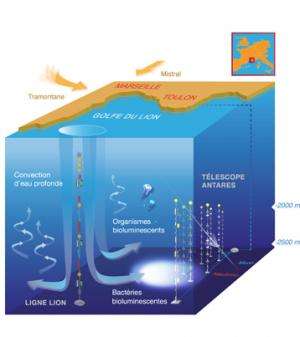Bioluminescence reveals deep-water motion in the Mediterranean

In 2009 and 2010, the underwater neutrino telescope ANTARES detected an unusual phenomenon: the bioluminescence of deep-sea organisms suddenly increased, revealing an unexpected connection between biological activity-bioluminescence-and the motion of water masses in the deep ocean. Convective motion in the Gulf of Lion provides deep waters with oxygen and nutrients that boost biological activity. Published on July 10th in PloS ONE, the work was carried out by a team coordinated by CNRS researchers from the Institut Méditerranéen d'Océanographie (CNRS / IRD / Aix-Marseille Université / Université du Sud Toulon-Var) and the Centre de Physique des Particules de Marseille (CNRS / Aix-Marseille Université).
Located off the coast of Toulon, the purpose of the ANTARES telescope is to detect very high energy cosmic neutrinos. These particles rarely interact with matter. However, when one of them strikes a water molecule, it can produce a charged particle called a muon, which emits photons as it moves. This is the radiation that is detected by the 900 ANTARES photomultipliers at a depth of 2,400 meters.
The deep sea is not as dark as might be supposed: 90% of deep-sea organisms are able to emit light, which plays a role in many ecological interactions such as prey attraction or reproduction-related behavior. Deep-sea bacteria, whether free, in symbiosis with animals or attached to suspended particles, are able to emit light continuously and are adapted to their environment, as shown by Christian Tamburini and colleagues in another article published last June.
Such bioluminescence did not adversely affect the ANTARES mission. However, two episodes between March and July in 2009 and 2010 literally dazzled the telescope. The background light intensity measured by the detector, which is usually in the range 40 to 100 kHz, suddenly soared to 9 000 kHz. This peak in bioluminescence coincided with an increase in water temperature and salinity. This enabled the researchers to establish a link between bioluminescence and convective motion in the Gulf of Lion.
During especially cold, dry winters, the temperature of surface waters in the Gulf of Lion falls, while their salinity increases due to evaporation. As a result, these water masses become denser than those underlying them, and they sink. This motion, known as convection, is a well-known phenomenon. These surface waters are rich in oxygen and nutrients. When they sink, they provide deep waters with resources that boost biological activity. It is this bloom of biological activity that ANTARES unexpectedly detected.
The researchers believe that measuring bioluminescence could become the best way of continuously monitoring biological activity in the deep sea. It would shed light on the impact of the motion of water masses and ocean circulation on living organisms. This is all the more important as phenomena such as deep water convection are likely to decline significantly over the coming century due to global warming. This decline will have a major impact on deep-sea ecosystems, which will be deprived of this input of nutrients and oxygen. The researchers now intend to determine the as-yet-unidentified light-emitting organisms detected by ANTARES, and develop instrumentation to measure bioluminescence both continuously and autonomously.
More information: Tamburini, C. et al. Deep-sea bioluminescence blooms after dense water formation at the ocean surface, PLoS ONE, 10 July 2013. doi: 10.1371/journal.pone.0067523
Journal information: PLoS ONE
Provided by CNRS


















